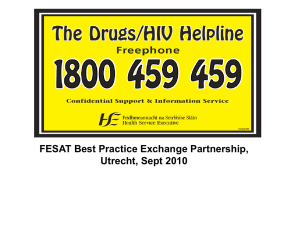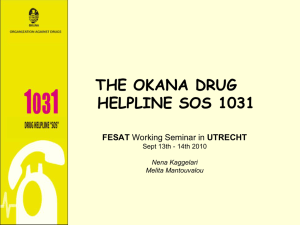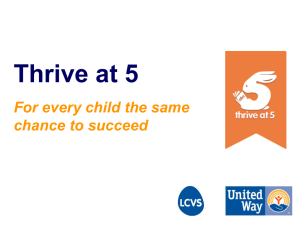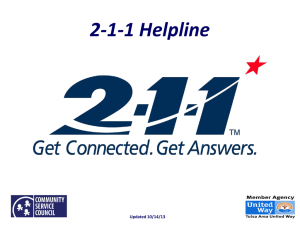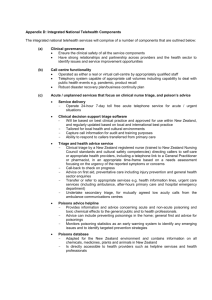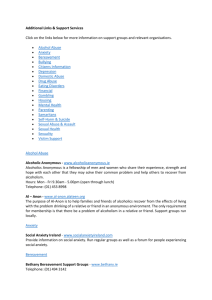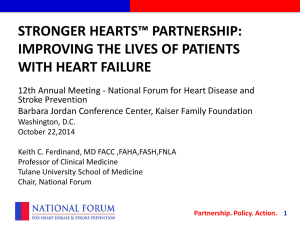BIS Evaluation Summary and Peer Review
advertisement
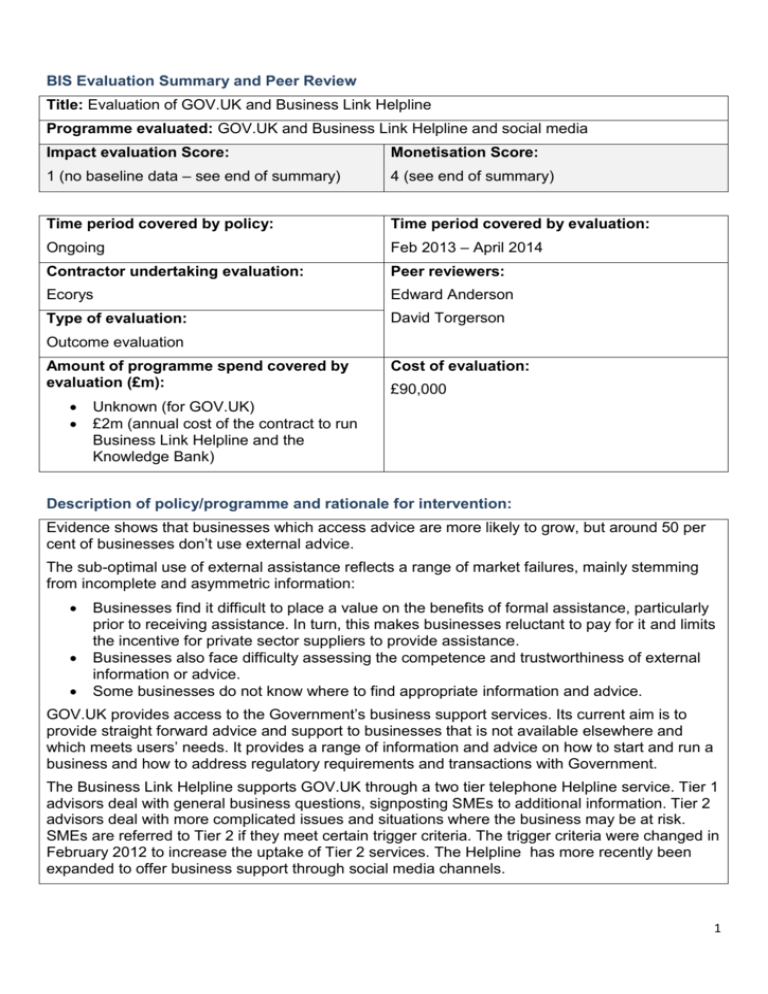
BIS Evaluation Summary and Peer Review Title: Evaluation of GOV.UK and Business Link Helpline Programme evaluated: GOV.UK and Business Link Helpline and social media Impact evaluation Score: Monetisation Score: 1 (no baseline data – see end of summary) 4 (see end of summary) Time period covered by policy: Time period covered by evaluation: Ongoing Feb 2013 – April 2014 Contractor undertaking evaluation: Peer reviewers: Ecorys Edward Anderson Type of evaluation: David Torgerson Outcome evaluation Amount of programme spend covered by evaluation (£m): Cost of evaluation: £90,000 Unknown (for GOV.UK) £2m (annual cost of the contract to run Business Link Helpline and the Knowledge Bank) Description of policy/programme and rationale for intervention: Evidence shows that businesses which access advice are more likely to grow, but around 50 per cent of businesses don’t use external advice. The sub-optimal use of external assistance reflects a range of market failures, mainly stemming from incomplete and asymmetric information: Businesses find it difficult to place a value on the benefits of formal assistance, particularly prior to receiving assistance. In turn, this makes businesses reluctant to pay for it and limits the incentive for private sector suppliers to provide assistance. Businesses also face difficulty assessing the competence and trustworthiness of external information or advice. Some businesses do not know where to find appropriate information and advice. GOV.UK provides access to the Government’s business support services. Its current aim is to provide straight forward advice and support to businesses that is not available elsewhere and which meets users’ needs. It provides a range of information and advice on how to start and run a business and how to address regulatory requirements and transactions with Government. The Business Link Helpline supports GOV.UK through a two tier telephone Helpline service. Tier 1 advisors deal with general business questions, signposting SMEs to additional information. Tier 2 advisors deal with more complicated issues and situations where the business may be at risk. SMEs are referred to Tier 2 if they meet certain trigger criteria. The trigger criteria were changed in February 2012 to increase the uptake of Tier 2 services. The Helpline has more recently been expanded to offer business support through social media channels. 1 Summary of key evaluation findings: The evaluation focussed on the how the services were used, the extent to which they met users’ needs and addressed market failures and the impact of the services, including economic estimates. Use of GOV.UK and Helpline, including Business Link social media Around 8.5 per cent of businesses (365,500) had accessed GOV.UK in the last year (a third of the proportion that used to access the old Business Link website). The Helpline received 36,000 calls over the same period. The typical GOV.UK user sought a specific piece of factual information, in particular related to employing people, tax or legal issues, or to undertake administrative activities. Many user respondents reported accessing the site regularly. Helpline users were most commonly calling about starting a business or funding. The Business Link social media had around 80,000 followers on Twitter and just under 5,000 Facebook likes at the time of the research. The survey suggests that just under two per cent of businesses had accessed Business Link social media in the last 12 months. Most GOV.UK users and non-users of the services who responded the survey expected to access business support on the internet in the future and many users reported accessing GOV.UK and the Helpline after finding results high on a search engine. There was evidence that the Helpline is supporting a transition to a web based service and helping improve understanding of GOV.UK. Meeting user needs and addressing market failures The majority of users of the services who responded to the survey had been able to access the information they were looking for and the information obtained was generally found to be practical, useful and valuable to their business. There were higher levels of trust among respondents in the information obtained from these services than in information obtained from other non-Government sources. The evidence suggests the services have a role to play in addressing market failures, particularly surrounding lack of trust and not knowing how to access business support. Impact Where user respondents had taken action, the information received from the services was widely considered to be an important factor in their decision. The economic impact estimates presented in this study are based on data from a small number of respondents (from between 3 and 92 respondents) and need to be treated with caution. However, based on the available data, it is estimated that over the 12 months covered by the survey, at least £32 million additional Gross Value Added has been generated from users of the services, which when compared to the relatively low cost of delivering the services, appear to be indicative of good value for money. Summary of cost-benefit/cost-effectiveness analysis (if applicable): Where established businesses who had responded to the survey had taken action after using GOV.UK or the Helpline, the majority did not expect to experience any change in business performance as a result of the improvements made (most wanted simple transactional information). However, among those that had sought more strategic advice, the impact was judged 2 to be significant. The economic impact estimates presented in this study are based on data from a small number of respondents and need to be treated with caution. Sensitivity analysis was conducted and the lower estimates of impact reported. Based on the available data, it is estimated that over the last 12 months, at least £17 million additional Gross Value Added (GVA) has been generated from GOV.UK only users, at least £8 million from Helpline only users and at least £7 million from users of both services combined. When compared to the relatively low cost of delivering these services, these positive estimates of GVA appear to be indicative of good value for money. Policy Response: GOV.UK provides access to the Government’s business support services. It aims to provide straightforward information to businesses that may not be available elsewhere, or is not easily accessible from other sources, and which meets users’ needs. The Business Support Helpline complements GOV.UK by providing bespoke information and signposting to customers with queries that they could not answer from using the website alone. The Helpline offers two tiers of support (Tier 1 for light-touch support and Tier 2 for more in–depth business support). The Business Support Helpline has more recently been expanded to offer business support through digital (web chat) and social media channels (Facebook and Twitter). The research provides new evidence on: the proportion of businesses using GOV.UK; reasons for using GOV.UK and Helpline, the types of queries being addressed and how and why the services are being used; the impact of the services, in terms of whether the users found the information they were looking for, how useful and valuable it was to their business, what part it played in any actions they took, whether it impacted on their business performance (or whether they expected it to); additional Gross Value Added generated from users of the services; whether the services were addressing business support market failures; synergy between the two services and their role in supporting a move to a web based service; the role of the internet and social media in business support. The research has demonstrated the impact GOV.UK and Helpline are having on the economy and for individual businesses. It has provided robust evidence on what businesses are using the services for and why they use them as opposed to other sources of support, the complementarity of the two support services and their contribution to a move to a primarily web based service. The findings are supporting work to further develop and improve business support provided through GOV.UK and the Business Support Helpline and into the development of digital and social media as a channel for delivery of business support. A Social Media Strategy is now in place at the Helpline to build the research, engagement and impact of social media as an advice channel. Evaluation Methodology 3 Description of methodology: The evaluation involved: a telephone survey with 1,647 users of GOV.UK and the Business Link Helpline (436 GOV.UK users, 380 Helpline users and 530 users of both services) and 301 non-users; 60 qualitative interviews with users of GOV.UK (24 interviews), the Helpline (25 interviews) and Business Link social media (11 interviews); and 9 consultations with stakeholders, to provide a more strategic view of the role of GOV.UK and the Helpline, while Ecorys also consulted with 6 Helpline staff to evaluate the effectiveness of the process. Sample GOV.UK users: a random sample of all businesses listed on Experian, followed by a random sample of businesses listed on Experian who were less than a year old and businesses with no employees. Helpline users and Helpline and GOV.UK users: random sample from a list of Helpline users within the previous 12 months who had agreed to be re-contacted. Tier 2 users (who receive more in-depth advice) were oversampled. Overall, a 10% response rate was achieved. Does the evaluation review the published policy objectives? Yes At what level are the main intended outputs and/or outcomes expected to occur? (What is the unit of analysis? For example: universities, businesses, individuals or nationally) SMEs Has sufficient time lapsed for the initial/full benefits to be estimated? Only initial benefits have been estimated as enough time has not lapsed to assess longer term benefits. Indeed, it is likely that the majority of impacts are lagged over a period of several years. Peer Review Comments on the appropriateness of data and outcomes: Edward Anderson: The two key outcome indicators for the evaluation are GVA and jobs created. This is standard practice for BIS evaluations and seems appropriate in this particular case as well. For future research on this or other related BIS evaluations it would be interesting to ask service users how much they would be willing to pay for the service. This would provide an alternative means to value the benefits of each scheme which could be compared with the results obtained via the GVA. Comments on internal validity: Edward Anderson: The evaluation is carried out on the basis of users’ own assessment of the extent to which the information obtained from GOV.UK had an impact on the performance of their business, in terms of turnover, employment, running costs, and exports, obtained via telephone surveys. Overall I would say that self-reported estimates of impact have low internal validity. This is not a criticism in itself, since it is not always possible to do evaluations with higher internal validity (e.g. randomised 4 control trials). Moreover, the report recognises the potential weaknesses of self-reported estimates. Comments on external validity: Edward Anderson: By contrast, the external validity of the evaluation appears quite high, since the estimates of impact are constructed on the basis of information directly from the users of the services themselves. Where key parameters are estimated using data from other sources, the report applies sensitivity analysis to these parameters. Comments on the quality of inferences and establishing causation: David Torgerson: The report is primarily a survey with some additional qualitative work. As far as I can see the evaluators have done a good job within the constraints that were set - it isn't an experimental evaluation rather a formative piece of work, which can influence how the service is delivered but not really answer how effective the service is - i.e., what would have happened if the service had not been available? Consequently, it would score only 1 on the scoring system as there isn't a control group or a before and after comparison. Any other comments: Cost-effectiveness and cost-benefit summary Justification for monetisation score: Provide a justification for the quality of the cost-benefit/cost-effectiveness analysis: Is it based on a robust impact evaluation? Did the evaluation assess against the objectives of the programme? Did the evaluation cover a significant sample of the intervention? Did the evaluation consider net benefits (not just gross)? Economic impact Estimates of the economic impact of GOV.UK and Helpline over a 12 month period are presented. The details of the economic analysis are discussed in the report but the lower estimates following sensitivity analysis are presented overall, due to the caveats outlined below and to minimise the risk of economic impact being overestimated. The analysis considers the cost savings to business due to users saving time and monetary expense from accessing business support through GOV.UK and /or Helpline, as well as the economic impacts due to businesses experiencing growth (measured through GVA and employment) as a result of additional actions taken to improve the business following usage of the services. All economic impact estimates in this study are derived from values provided by respondents to the quantitative survey. With this in mind, it is important to the note the following caveats when interpreting the analysis in this study. In many cases, the number of respondents providing a quantitative estimate in response to some questions was very low (between 3 and 92 respondents). Therefore, the average (mean) response is in some cases very sensitive to specific individual responses. Sample sizes for all estimates are provided in the footnotes. In this analysis, the estimates of the counterfactual (the outcomes that would have occurred in the absence of GOV.UK) are based solely on respondents’ own assessment of additionality. A more robust assessment of additionality would be to measure any changes 5 in outcomes in a “control group” or “comparison group” of non-users, and only attribute impact where there are significant differences between the outcomes experienced by users and those experienced by non-users in a similar time frame. However, such an exercise was beyond the scope of this evaluation. Nevertheless, it should be noted that self-reported additionality can be subject to optimism bias, where beneficiaries overstate the true impact of a particular factor in any overall change in performance. To estimate the aggregate impact of GOV.UK usage on the England economy, GVA impacts due to turnover growth are grossed up according to the estimated number of established businesses using the services in a 12 month period. For GOV.UK, any impacts on pre-starts due to businesses being created have not been included in these aggregate estimates, as the survey sample does not adequately represent pre-starts and therefore insufficient inference can be made about these impacts. Moreover, time and cost savings have not been included in the aggregate estimates as these are assumed to be included in the GVA impacts or (in the case of cost savings) to be offset by reduced revenue to business support providers elsewhere in the economy. Sensitivity analysis has been undertaken to test the sensitivity of the results to changed assumptions about the number of users, the persistence of impacts and an alternative calculation of GVA based on changes in employment rather than turnover. Value for money Value for money estimates presented within the report are based on the original estimates of economic impacts. GOV.UK: Disaggregated costs for the business sections of GOV.UK were not available at the time of the research. The analysis suggests that GOV.UK would represent value for money if the cost of support provided to established SMEs through the website is less than £66 million per year. Helpline: The cost of the contract to run the Helpline and Knowledge bank was £2 million a year, which suggests the Helpline may be generating £28 of benefits to business for every £1 spent on the service (if the complementary impact of GOV.UK is included). Sensitivity analysis/key assumptions: Please describe the key assumptions of the analysis and the conclusions of sensitivity analysis. Key assumptions: Additionality weights were assigned to user responses to two questions in the quantitative survey: o how likely it was that they would have obtained the information they received from GOV.UK / Helpline elsewhere (Tables 35 and 81 for GOV.UK and Helpline respectively); o how important they felt the information received was to their decision to start a business or take action (Tables 36 and 82 for GOV.UK and Helpline respectively). Displacement was estimated from the quantitative survey to estimate the extent to which any impact on turnover and employment would displace economic activity from elsewhere in the economy. Survey respondents were asked to estimate the percentage of their sales that would be taken up by competitors in the event of them ceasing to trade and the percentage of these competitors based in the UK. Average working time costs £21 per hour (p.58), from BIS (2012) Assessment of the Business Link Helpline, p84, https://www.gov.uk/government/uploads/system/uploads/attachment_data/file/36780/121153-assessment-of-business-link-helpline.pdf . GVA: turnover ratio 0.283 (p.62 ), from Annual Business Survey, 2012 Provisional Results (Total GVA in UK in 2012 / Total turnover in UK in 2012 = 0.283), 6 http://www.ons.gov.uk/ons/publications/re-reference-tables.html?edition=tcm%3A77323688. GVA impacts associated with business support persists for 3 years (p.63, p.123), Department for Business, Enterprise and Regulatory Reform (2009) Impact of RDA Spending – National Report – Volume 1 – Main Report, Table 53, http://www.berr.gov.uk/files/file50735.pdf. GVA generated in future years is discounted at a rate of 3.5% per year (p.63, p.123), HM Treasury assumption. New businesses survive for 4 years on average (p.117), ONS (2013) Business Demography, 2012, Table 4, http://www.ons.gov.uk/ons/dcp171778_340530.pdf. Sensitivity analysis Sensitivity analysis was conducted to show how the estimates changed when: GVA impacts are assumed to persist for one year rather than three years (or four years for pre-start Helpline users); calculating GVA impacts from employment estimates rather than turnover estimates. In addition, for GOV.UK, assumptions around the number of users per year were adjusted, based on a confidence interval of +/-_two percentage points around the estimated 8.5 per cent of the business population in England. The specified changes in assumptions made substantial changes to the estimated cumulative net additional GVA impacts. Therefore, emphasis is placed on the lower bound estimates for GVA impacts in the report. Direct costs to Exchequer of programme: £m Total Capital DEL 2 Year 0 Year 1 Year 2 Year 3 Year 4 Year 5 Resource DEL AME Total 2 7 Economic costs and benefits of programme: Price base year 2013/2014 Present value 2013/2014 base year Costs (£m) Transition Average Total (constant annual (present price) value) Discount rate 3.5% Benefits (£m) NPV Net BCR (£m) (PV of Transition Average Total net (constant annual (present benefits price) value) / PV of net costs) Low High Best estimate Note: The costs and benefits of the different elements (GOV.UK, Helpline and Helpline and GOV.UK combined) are outlined below. Description and size of key monetised costs: Description of the level of costs used: Are public sector costs, total costs or another method used? Annual cost of the contract to run the Helpline and Knowledge Bank is £2m. Other key non-monetised costs: A reliable, disaggregated estimate of the cost of the business sections of GOV.UK was not available at the time of the research. Description and size of key monetised benefits: Does the benefit calculation take into account multiplier, displacement and deadweight effects? Are benefits net or gross? Net monetised benefits of GOV.UK and Business Link Helpline, taking into account deadweight and displacement (Tables 40, 85, 86 and 87). Cost savings for business from using GOV.UK /Helpline instead of alternative support (one-off): £3.05m (£1.9m for users of GOV.UK only, £0.48m for users of Business Link Helpline only, and £0.67m for users of both). Time savings from using GOV.UK / Helpline (one-off) – £8.87m (£3.8m for users of GOV.UK only, £0.67m for users of Business Link Helpline only, and £4.4m for users of both). Average GVA per year for new businesses – £13.5m (£7.7m for users of Business Link Helpline only, and £5.8m for users of both. Did not extrapolate from survey of GOV.UK users due to potential bias.) Average increase in GVA per year for established businesses – £24.77m (£23.2m for users of GOV.UK only, £0.64m for users of Business Link Helpline only, and £0.93m for users of both). Total monetised benefits of GOV.UK/Helpline (additionality, displacement effects and discounting) (Tables 41, 88 and 89). 8 £122m (£66m for users of GOV.UK only, £31.2m for users of Business Link Helpline only, and £24.8m for users of both). Total monetised benefits of GOV.UK/Helpline (additionality, displacement effects and discounting), lower band from sensitivity analysis (Tables 42 and 90). At least £32m (£17.4m for users of GOV.UK only, £8.4m for users of Business Link Helpline only, and £6.7m for users of both). Other key non-monetised benefits: Additionality of support associated with GOV.UK and Helpline (the extent to which the service provided support that would not have been available elsewhere) was relatively low. Displacement was estimated to be relatively high suggesting that any GVA or employment gains among beneficiaries may be displacing GVA and employment from elsewhere in the economy. Net non-monetised benefits of GOV.UK / Helpline, taking into account deadweight and displacement (Tables 40, 86 and 87): Jobs created in new businesses – 550 jobs (280 jobs for users of Business Link Helpline only, and 270 jobs for users of both. Did not extrapolate from survey of GOV.UK users due to potential bias.) Jobs created or safeguarded in established businesses – 3,100 jobs (2,800 jobs by users of GOV.UK only, 160 jobs for users of Business Link Helpline only, and 140 jobs for users of both). Robustness of monetised costs and benefits: The economic impact estimates presented in this study are based on data from a small number of respondents (from between 3 and 92 respondents) and need to be treated with caution. However, based on the available data, it is estimated that over the 12 months covered by the survey, at least £32 million additional Gross Value Added has been generated from users of the services, which when compared to the relatively low cost of delivering the services, appear to be indicative of good value for money. Peer Review Evaluation peer review comments on comprehensiveness, clarity, robustness and best practice of cost benefit/cost effectiveness analysis: Edward Anderson: Overall the CEA and CBA in the report is clear and well implemented, with appropriate methods of including and valuing benefits and with sensitivity analysis incorporated. It is somewhat unfortunate that dis-aggregated costs for the business section of GOV.UK were not available in time for the report. This means that the report can only gives the net economic benefit of GOV.UK, and conclude that the project delivers value for money if the annual cost is less than this benefit. Although this makes sense up to a point, a comprehensive assessment of the project can only be reached once the costs are known. 9 Impact Evaluation Score The higher the score the more capable the evaluations are to demonstrate that the outcome observed is due to or caused by the intervention. Impact scale follows new guidance on ‘Quality on Impact Evaluation’ which has been approved by the Cross Government Evaluation Group and will be published alongside the Magenta Book. • Score 5: Random allocation of treatment and control group or matched treatment and control group. Actual before and after data in both groups. • Score 4: Treatment and comparison group. Actual before and after data in both groups. • Score 3: Predicted versus actual (modelled), predicted base on actual baseline data. • Score 2: Actual before and after • Score 1: No baseline data Scoring Monetisation The higher the score the more information the evaluation contains in terms of analysing the cost of the intervention and the additional benefits to the economy. • Score 5: Input, output, outcome data additional Benefit Cost Ratio (BCR), NPV set aside some other not monetised impact measures, fuller cost benefit analysis or cost effectiveness analysis that compares the costs of alternative ways of producing the same or similar outputs • Score 4: Input, output, outcome data, calculation of additional Benefit Cost Ratio, Net Present Value • Score 3: Input, output, outcome data calculation of Gross BCR not additional or not clear if additional • Score 2: Input data (just covers money spent) • Score 1: No monetisation at all 10
